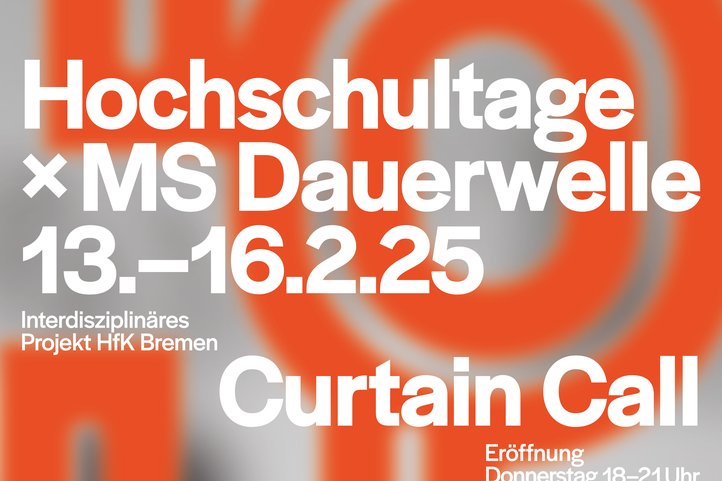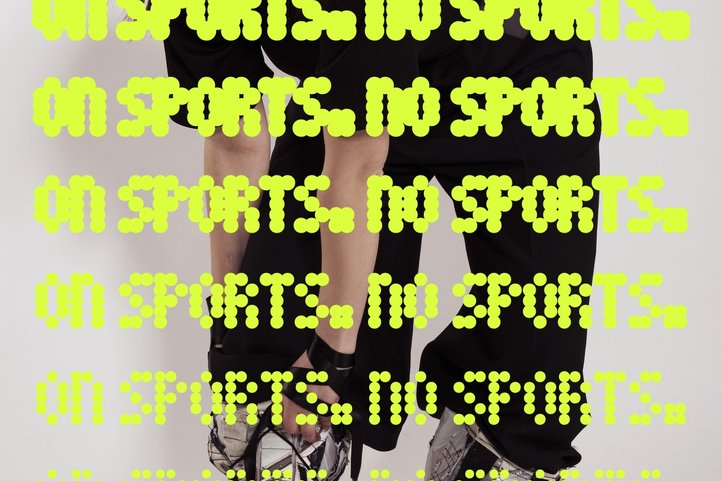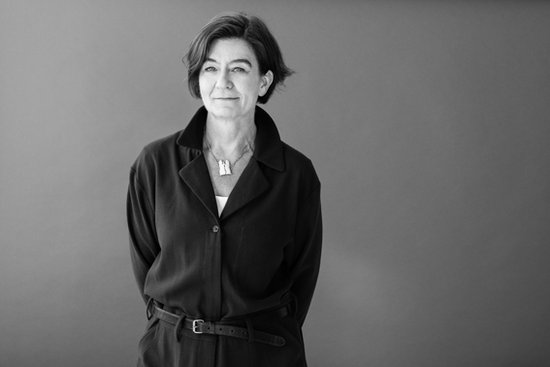
Prof. Dorothea Mink
- Studiengang Integriertes Design
- E-Mail d.mink@hfk-bremen.de
- Telefon +49 421 9595-1239
Vita
Ausbildung
Diplom Modedesign, Fachhochschule Hamburg.
Beruflicher und künstlerischer Werdegang
Bereits während des Studiums als Modedesignerin tätig für Miss Britt; anschließend für Olsen, Wolfgang Joop, Jil Sander, diverse freiberufliche Tätigkeiten.
Lehraufträge an der Fachhochschule Hamburg; danach Berufung zur Professorin an der Hochschule Hannover. 2002, Berufung an die Hochschule für Künste Bremen.
Seither aktiv tätig in unterschiedlichen Feldern und Gremien der Hochschul-Selbstverwaltung wie zum Beispiel das Amt der Frauenbeauftragten, das Amt der Pro-Dekanin, Mitglied des Akademischen Senats der Hochschule, Mitglied des Fachbereichsrats Kunst und Design, Mitglied des Prüfungsausschusses Kunst und Design. Tätigkeiten als Gutachterin: DAAD, jährliche Vergabe von internationalen studentischen Stipendien im Aus- und Inland; ACQUIN, Akkreditierungs-, Zertifizierungs- und Qualitätssicherungs-Institut (u. a. Weißensee Kunsthochschule Berlin; Universität der Künste Berlin) sowie als externe Gutachterin für Berufungsverfahren an Kunsthochschulen (Universität der Künste Berlin; Burg Giebichenstein Kunsthochschule Halle, Campus Design)
- Lehre und Lehrkonzept
„Kleidung hat viel wichtigere Aufgaben, als uns nur warm zu halten; sie verändert unseren Blick auf die Welt und den Blick der Welt auf uns." Orlando – Roman von Virginia Woolf, erschienen 1928
Die Kreation von Kleidung hat sich heute zu einem multitonalen, komplexen Phänomen der zwischenmenschlichen Informationsvermittlung entwickelt, grenzüberschreitend zwischen den Geschlechtern und den Generationen, universal im Ich und im Wir. Kleidung, Schmuck, Frisur oder Kosmetik zählen zu den traditionellen Oberflächen modischer Gestaltung. Bodybuilding, Bodyshaping, Bodyforming, Trivialkunstwerke wie Tattoos, Piercings oder Brandings transportieren die tieferen Schichten des Selbst an die Oberfläche. Kleidung ist unsere zweite Haut, Mode performt unser erweitertes Ich. Mode, mit der sich ein Mensch identifizieren kann. Stehen bei Bekleidung im Allgemeinen die Funktion und der Nutzen im Vordergrund, so haben die Botschaften der Mode immer eine tiefergehende Bedeutung. Mode entwickeln heißt also: Die Grundwerte zwischenmenschlicher Kommunikation durchschauen und diese Erkenntnisse in eigene Entwurfsthemen transferieren.
Erste Priorität der Lehre hat der praktische Prozess der Modellentwicklung: Wie lässt sich zwei-dimensionaler Stoff mit unterschiedlichen Methoden in drei-dimensionale Körperarchitekturen umwandeln. Weitere Entwicklungsschritte bilden: Der ästhetisch unabhängige Blick auf die Vielfalt menschlicher Darstellung im Rahmen vielgestaltiger kultureller Welten. Ebenso bedeutungsvoll ist die bewusste Wahl von Material und Materialität, gleichbedeutend mit der Einbeziehung neuer Technologien in Hinblick auf schwindende Ressourcen, Nachhaltigkeit und Recycling.
In dem auch kooperativ möglichen Grundlagenangebot wird in gestalterischen Übungen zu Form, Material und Farbe experimentiert. Priorität haben jedoch der Bezug zum Körper und zu körpernahen Produkten. Dabei werden Methoden und Strategien zur Ideen- und Entwurfsfindung analog und digital in 2D und 3D erprobt. Auf Grundlage von Rechercheübungen wird das Entstandene gemeinsam diskutiert und bewertet.
In weiterführenden Lehrveranstaltungen durchleben die Studierenden in Individual- oder Teamprojekten einen kompletten Gestaltungsprozess von der Recherche bis zur spezifischen Umsetzung in den Werkstätten. Von der Vorerfahrung abhängig entstehen dabei Modelle realistisch eins-zu-eins oder als Prototypen sowie auch experimentelle Kollektionen inklusive Accessoires. Die Projekte können in internen oder externen Kooperationen stattfinden. Idealerweise begleitet ein abgestimmtes Theorie- und Wissenschaftsangebot die Lehrveranstaltungen.
Im Masterstudium werden alle Studienprojekte individuell begleitet. Ziel ist die Herausbildung und Festigung der eigenständig kreativen Identität. Gefördert wird einerseits eine vertiefende Spezialisierung in der Mode, zum Beispiel in der Modellentwicklung, in der Kollektionskonzeption oder in der Konzeption eines eigenen Labels. Die individuelle Projektbetreuung zielt andererseits auf eine Neuverknüpfung von Disziplinen und Tätigkeitsfeldern wie etwa die interdisziplinäre Verortung von Mode mit diversen Schnittstellen und Kooperationsmöglichkeiten in Bezug auf andere Gestaltungsformen wie Produkt, Raum, stilles und bewegtes Bild, Illustration, Grafik oder Performance eingesetzt werden.
- Projekte und Kooperationen (Auswahl)
- 2020 Neo.Fashion Groupshows für Absolvent:innen von 7 staatlichen Hochschulen mit Prof. Ursula Zillig; Neo Fashion Orchestra zusammen mit Prof. Raphael Sbrzesny.
- 2019 Neo.Fashion Groupshows für Absolvent:innen von 4 staatlichen Hochschulen.
- 2017 A_Life, Modeperformance Absolvent:innen und Studierende mit Prof. Ursula Zillig und Prof. Kai Lehmann.
- 2016 _UNTER, Modeperformance im Aquarium des Berliner Zoos im Rahmen der MBFW Berlin.
- 2016 ACHT, Modeperformance der Absolvent:innen im Rahmen der MBFW Berlin gemeinsam mit Prof. Ursula Zillig und Prof. Kai Lehmann.
- Internationale Tagungen, Publikationen, Vorträge und Ausstellungen (Auswahl)
- 2005 Die Tagung FASHION BODY CULT,
- 2007 erschien das gleichnamige deutsch-englische Buch bei arnoldsche ART PUBLISHERS, herausgegeben gemeinsam mit Prof. Dr. Elke Bippus.
- 2010 Die Tagung OUT OF ORDER – STÖRUNG ALS PRINZIP, entwickelt gemeinsam mit Prof. Dr. Andrea Sick. Die damit einhergehende Ausstellung und Performance im Wilhelm Wagenfeld Haus Bremen wurde zusammen mit dem Kopenhagener Künstlerduo Vibskov & Emenius gestaltet.
- 2011 wurde das englisch-sprachige Buches dazu bei arnolsche ART PUBLISHERS veröffentlicht.
- Ab 2017 bis heute, BREATHE Vol. 1 bis 5, An Idea About Fashion, herausgegeben gemeinsam mit Prof. Andrea Rauschenbusch, Prof. Ursula Zillig und dem Fotografen Joachim Baldauf.
- 2019 CHARLES JAMES – THE COUTURE SECRETS OF SHAPE; englisch-sprachige Publikation bei Spector Books, Leipzig und artbook (D.A.P.) New York; herausgegeben gemeinsam mit Homer Layne und Prof. Iris Maria vom Hof.
- Forschung
2012 bis 2019 Wissenschaftliche Beschäftigung mit Leben und Werk des anglo-amerikanischen Couturiers Charles James. Vorträge dazu im Kulturforum Berlin, Museum des Fashion Institute of Technology NYC www.youtube.com/watch?v=8ZOGY1G0NCQ, Victoria & Albert Museum London, sowie Ausstellungen in Paris und Mailand.
Seit 2021 Explorationsprojekt der HfK Bremen gemeinsam mit Prof. Ursula Zillig: „Von analogen Prinzipien zu hybriden Praktiken – Forschungen zu den Auswirkungen der Digitalisierung auf Mode zwischen hybriden Entwurfsprozessen und digitaler Produktionstechnik". Ziel des interdisziplinären Explorationsprojektes „Von analogen Prinzipien zu hybriden Praktiken" ist es, für die Systeme der Mode, die durch die Digitalisierung im Bereich Material und Tendenzen zur Individualisierung von Körper- und Raumkonzeptionen fundamentale Veränderungen in ihren Prozessen erfahren haben, erste methodologische und anwendungsbezogene Ansätze für die Untersuchung von intelligenten und automatischen Schnittstellen zwischen den beiden „Welten" des freien, kreativen Entwurfsprozesses und individualisierter, automatisierter digitaler Produktionstechnik zu erproben und ausgehend von der Materialforschung für eine mögliche weitere Antragstellung zu entwickeln. Eine Vortragsreihe, sowie Workshops und Projekte mit Studierenden haben das Unterfangen begleitet. Eine Publikation ist in Vorbereitung.
Aktuelle Kurse
- TWISTED AND MODIFIED – FLÄCHE, KÖRPER UND RAUM Die einfachste, grundlegende Form für einen Schnitt ist das quadratische Stück Stoff als Ursprung aller Kleidung. Wird es übergestreift, entwickelt ein viereckiges Tuch geschwungene, fließende Formen, die die organische Natur des menschlichen Körpers widerspiegeln. Durch Wickeln, Verdrehen, Drapieren und Binden werden die Formen komplexer, weil sich das Material dem Körper anpasst. Wie das gewickelte Tuch eines Neugeborenen ist Kleidung eines der persönlichsten Hilfsmittel, mit denen sich Menschen vor der Umwelt schützen, um sich damit an ihre vorgefundenen Lebensbedingungen anzupassen. Demgegenüber: Neben dieser überlebenswichtigen Schutzfunktion bilden Farbe, Form, Textur, die Bewegung des Stoffes die kommunikative, spielerische Seite von Kleidung ab. Dieser Vorgang ist weder an Zeit noch an Geografie gebunden; er ist in vielen Kulturen allgegenwärtig, in diesem Moment ebenso wie in der Zukunft. Ziel: Die Entwicklung von textilen Prototypen Dieser Workshop lädt zum Experiment mit textilen Körperhüllen ein. Ausgangspunkt ist die Ästhetik, die einem Stück Stoff innewohnt, bevor es in ein Kleidungsstück verwandelt wird. Im kreativen Interesse stehen das Sich-Bekleiden, sich zu fühlen und sich zu begreifen. Auf diese Weise findet das entworfene Kleidungsstück seine Vollendung und wird lebendig, sobald es angezogen ist. ---
- BLICKWINKEL DES PARADOXEN -- HEITERE ÜBERTREIBUNGEN ...trotz Allem die Lust am Mode machen nicht verlieren! Im Fokus steht ein experimenteller Einstieg im Umgang mit unserer zweiten Haut, untersucht wird die "Sprache der Kleidung". Geplant sind Experimente mit Materialien, die bereits ein Vorleben hatten, Übungen mit Formfindung, dem Einsatz von Farbe und einem Spiel mit Styling. Es ist wichtig, dass Ihr Lieblingstücke aus Eurem Kleiderschrank oder von Freunden, aus der Familie mitbringt. Keine Sorge! Wir werden die guten Sachen nicht zerschneiden oder demontieren, sie sind wichtige Ausgangsmaterialien für Eure Entwürfe! Details für die Teilnehmer:innen folgen vor Kursbeginn. --- Event Description: ...despite everything, don't lose the joy of making fashion! The focus is on an experimental introduction to dealing with our second skin, exploring the "language of clothing." Planned are experiments with materials that have already had a previous life, exercises in finding form, the use of color, and playing with styling. It is important that you bring favorite pieces from your closet or from friends and family. Don't worry! We won't cut up or dismantle your favorites; they are important starting materials for your designs! Details for participants will follow before the course begins.
- EXPERIMENT ZWISCHEN MENSCH UND LUFT UND HIMMEL Choreografie aus Wind und Bewegung (Block B) Eine Kooperation mit Anna Rubin aus Österreich, international bekannte Drachenbauerin. https://www.annarubin.at Unsere Lehrgebiete werden im Entwurfsprozess interdisziplinär miteinander verschränkt. Das Lehrangebot ist für alle Studiengänge offen. Frau Rubin wird für zwei Drachenbau-Workshops aus Klagenfurt anreisen. DAS PROJKET Im wahrsten Sinne ganz oben steht der Wunsch zum Fliegen: Wie Ikarus in der Antike, später Eilmer von Malmesbury, der im Mittelalter mit einfachen Flügeln vom Kirchturm sprang, nicht zuletzt die ausgeklügelten Flugmaschinen von Leonardo da Vinci. Das Auge im Himmel – eine Erweiterung der individuellen Körperlichkeit. Sehen und gesehen werden im Himmel und auf Erden. Der Drachen als Schnittstelle von Handwerk, Tradition, Wissen, Technik, Design und Kunst. Die Theorie beleuchtet das historische, mythologische und kulturelle Umfeld des Drachens. Assoziative Formfindung, narrativ oder symbolisch. Das Steigenlassen des Drachens inspiriert zu einer eigenen Drachenform und zur individuellen Art Kleidung. Der Drachen greift in den Himmel, verwurzelt sich, vermischt sich mit dem Oben, dem Raum und der Landschaft. Durch den fliegenden Drachen wird man Teil von Luft, Wind, Höhe und Aussicht. Energie wird freigesetzt, auf ganz eigene Weise wundersam und schön. Ein Glücksgefühl der Identifikation mit sich und der Welt stellt sich ein. ZIELE DER LEHRVERANSTALTUNG Im Fokus stehen Entwurf und Entwicklung eines Flugdrachens sowie die Kleidung der Drachenlenker:innen. Gruppenarbeiten sind möglich. In diesem Projekt korrespondieren Bautechniken für Drache und Skelett, Schnittkonstruktion und Gewand miteinander. Durch die Technik des Bambusspaltens werden feine Bambusleisten erzeugt, um daraus das Skelett des Drachens zu bauen. Die Vermessung des Körpers – parallel zum Bau der Flugobjekte werden Idee und Form, Charakter und Silhouette für die Drachenlenker:innen entwickelt. Materialien für Flugmembran und Körperhülle: Die traditionellen Drachenbaumaterialien Bambus und Papier bilden flugtaugliche Objekte analog zu Körper und Haut. Im Dialog mit der menschlichen Bewegung und dem handwerklichen Umgang mit dem Material sowie das Wissen um den Wind bilden Basis für das künstlerische Ergebnis. Erste Woche: Workshop I mit Anna Rubin von 15.12. bis 18.12.2025 Montag bis Mittwoch von 10:00 bis 17:00 Uhr, Donnerstag von 10:00 bis 16:00 Uhr im Auditorium Grundlagen und Ziele im Drachenbau Kontaktaufnahme mit der Geschichte und Mythologie des Drachens in unterschiedlichen Kulturen. Das Bauen von Papierdrachen ermöglicht ein weites Feld von Erfahrungen: Das Kennenlernen der Materialien Bambus und Papier. Das Färben des Chinapapiers mit den kostbaren, bunten Zeichentuschen nach der japanischen Färbetechnik Shibori. Die Auseinandersetzung mit den konstruktiven und technischen Elementen des Drachenbaus. Das Erlernen der Fingerfertigkeiten mit Waage- und Spannschnur als auch mit der Flugleine. Das Entwickeln und Gestalten einer einfachen flugfähigen Form. Gleich im Anschluss folgen die ersten Schritte für den Aufbau eines individuellen Flugobjektes, bei dem anstatt Papier optional andere Materialien zum Einsatz kommen können. Und schließlich das Erfolgserlebnis den selbstgebauten Drachen in Verbindung mit dem Erlernen von Flugtechnik und Windgesetzen zu fliegen. Technische Vorkenntnisse sind nicht erforderlich. Zweite bis fünfte Woche – ab 05.01.2026: Montag und Dienstag von 10:00 Uhr bis 16:30 Uhr und Mittwoch von 10:00 Uhr bis 12:00 Uhr in Studio 4.10.040 Themen sind zum einen die Entwicklung und Realisierung des Outfits. Zum anderen die korrespondierende Entwurfsbearbeitung des dazugehörigen individuellen Drachens. Menschliches Maß steht in Relation zum Flugobjekt: Weiteres Ziel ist die Umsetzung einer Körperhülle. Die eigenen Vorstellungen werden in ein thematisch passendes Kleidungsstück übersetzt. In Form einer Geschichte, einer Zeichnung, eines Fotos, eines vorhandenen Stoffes, eines zerschlissenen Lieblingsteils oder nur eines Gedankens. Für die Entfaltung einer unverwechselbaren Handschrift kommen Schnitt- und Verarbeitungsmethoden zum Einsatz. Die Wahl der richtigen Grundform, die sorgfältige Ausarbeitung der dreidimensionalen Proportionen und Linienführungen sind entscheidend für das Gelingen der Realisierung. Der methodische Ansatz beeinflusst maßgeblich den Stil des Entwurfs. Die künstlerische Intention ist durch ästhetische Gesichtspunkte und Stilfragen geprägt. Schnittkonstruktionskenntnisse der Mode werden nicht vorausgesetzt, dafür Engagement, Freude und Sorgfalt. Sechste Woche: Workshop II mit Anna Rubin von Montag, 02.02. bis Mittwoch, 04.02.2026, täglich von 10:00 bis 16:30 Uhr in Halle XIA1 Realisierung des individuellen Flugdrachens. Siebte Woche: Fertigstellung des Kleidungsstücks und kollektive Planung für die Präsentation der Ergebnisse. Montag und Dienstag von 10:00 Uhr bis 17:00 Uhr und Mittwoch von 10:00 Uhr bis 16:00 Uhr im Studio 4.10.040 --- A collaboration with Anna Rubin, internationally renowned kite maker from based in Austria. https://www.annarubin.at Our teaching areas are interwoven in an interdisciplinary manner in the design process. The course is open to all study programmes. Ms. Rubin will travel from Klagenfurt for two kite-making workshops. THE PROJECT Our desire as humans to fly is the main force behind the course we are offering: Like Icarus in ancient times, later Eilmer of Malmesbury, who leaped from a church steeple with hand made wings in the Middle Ages, and not least the sophisticated flying machines of Leonardo da Vinci. The eye in the sky – an extension of the individual's physicality. To see and be seen in the sky and on earth. The kite as an interface between craftsmanship, tradition, knowledge, technology, design, and the arts. Theoretical considerations illuminate the historical, mythological, and cultural context of the kite. Associative form-finding, narrative or symbolic. Flying a kite inspires the creation of one's own kite shape and also a unique style of clothing. The kite reaches into the sky, takes root there, and blends with the sky, space, and landscape. Through the flying kite, one becomes part of the air, wind, heavenly heights and views from up above. Energy is released, wondrous and beautiful in its own unique way. A feeling of happiness arises from an ascension merging our selves with the world. OBJECTIVES OF THE COURSE The focus is on the design and development of a flying kite as well as the clothing of the kite runner. Group work is possible. In this project, construction techniques for the kite and skeleton, pattern construction, and clothing correspond with one another. Using the technique of splitting bamboo, fine bamboo strips are crafted to build the kite's skeleton. Mapping the body – parallel to the construction of the flying objects, the idea and form, character, and silhouette are developed for the kite runners. Materials for the flying membrane and body shell: The traditional kite-making materials bamboo and paper create flight-capable objects analogous to the body and skin. In dialogue with human movement and the skilled handling of the material, as well as knowledge of the wind, form the basis for the artistic result. First Week: Workshop I with Anna Rubin from December 15th to 18th, 2025 Monday to Wednesday from 10:00 a.m. to 5:00 p.m., Thursday from 10:00 a.m. to 4:00 p.m. in the auditorium Fundamentals and Goals of Kite Making Approaching the history and mythology of kites in different cultures. Making paper kites opens up a wide range of experiences: Getting to know the materials bamboo and paper. Dyeing Chinese paper with precious, colourful drawing inks using the Japanese Shibori dyeing technique. Exploring the structural and technical elements of kite building. Learning dexterity with the bridle and tension cord, as well as the flying line. Developing and designing a simple, flyable shape. This is immediately followed by the first steps in building a custom flying object, optionally using other materials instead of paper. And finally, the sense of achievement of flying the self-made kite, combined with learning flight techniques and becoming acquainted with the speed, force and directions of wind. No prior technical knowledge is required. Second to fifth weeks – starting January 5, 2026: Mondays and Tuesdays from 10:00 a.m. to 4:30 p.m. and Wednesdays from 10:00 a.m. to 12:00 p.m. in Studio 4.10.040 Topics include the development and realisation of the outfit. Second, the associated design of the corresponding individual kite. Human dimensions are being put in relation to the flying object: Another goal is the creation of a body shell. The students' own ideas are translated into a thematically appropriate garment. This could happen in the form of a story, a drawing, a photograph, an existing fabric, a worn-out favourite item, or just a thought. Cutting and processing methods are used to develop a distinctive, personal style. The choice of the appropriate basic shape and the careful development of three-dimensional proportions and lines are crucial for the success of the project. The methodical approach significantly influences the style of the design. The artistic intention is shaped by aesthetic considerations and stylistic issues. Knowledge of fashion pattern construction is not required, but commitment, enthusiasm, and diligence are. Sixth Week: Workshop II with Anna Rubin from Monday, February 2nd Until Wednesday, February 4, 2026, daily from 10:00 a.m. to 4:30 p.m. in Hall XIA1 Creation of the individual kite. Seventh Week: Completion of the garment and collective planning for the presentation of the results. Monday and Tuesday from 10:00 a.m. to 5:00 p.m. and Wednesday from 10:00 a.m. to 4:00 p.m. in Studio 4.10.040
- Mentoring bei Dorothea Mink Fortlaufende persönliche Beratung: Das Modul setzt sich aus regelmäßigen ‚One-on-One‘ Treffen der Mentorin/ des Mentors und des Mentees zusammen. Die Treffen können vereinzelt auch in Kleingruppen oder mit allen Teilnehmer:innen stattfinden. ---
- Integrierendes Projekt (zweites Semester) bei Dorothea Mink Meine BA Veranstaltungen stehen zur Auswahl, Details und Termine unter: ID.BA.GL1.011 Gestaltungsgrundlagen TWISTED AND MODIFIED – FLÄCHE, KÖRPER UND RAUM CP: 2,0 (ECTS 24) Montag, 20. bis Freitag, 24. Oktober 2025 ID.BA.GL1.032. Gestaltungsgrundlagen BLICKWINKEL DES PARADOXEN -- HEITERE ÜBERTREIBUNGEN CP: 2,0 (ECTS 24) Montag, 03. bis Freitag, 07. November 2025 ID.BA.GP.1-4.14. Gestalterische Praxis B EXPERIMENT ZWISCHEN MENSCH UND LUFT UND HIMMEL Choreografie aus Wind und Bewegung Eine Kooperation mit Anna Rubin aus Österreich, international bekannte Drachenbauerin. https://www.annarubin.at CP 9 Vom 15. Dezember 2025 bis 13. Februar 2026 Alternativ biete ich den MA Studierenden an, individuell abgestimmte persönliche Projekte zu betreuen. In Einzelterminen oder in kleinen Gruppen oder Plena. Rückfragen gerne unter: d.mink@hfk-bremen.de --- My BA courses are available for selection. Details and dates can be found at: ID.BA.GL1.011 Design Principles TWISTED AND MODIFIED – SURFACE, BODY AND SPACE CP: 2.0 (24 ECTS) Monday, October 20th to Friday, October 24th, 2025 ID.BA.GL1.032 Design Principles PERSPECTIVE OF THE PARADOX -- CHEERFUL EXAGGERATIONS CP: 2.0 (24 ECTS) Monday, November 3rd to Friday, November 7th, 2025 ID.BA.GP.1-4.14 Design Practice B EXPERIMENT BETWEEN HUMAN BEINGS, AIR AND SKY Choreography of Wind and Movement A collaboration with Anna Rubin from Austria, internationally renowned kite maker. https://www.annarubin.at CP 9 From December 15, 2025, to February 13, 2026 Alternatively, I offer MA students the opportunity to supervise individually tailored personal projects. This can be done in one to one, in small groups, or in plenary sessions. For inquiries, please contact: d.mink@hfk-bremen.de
- Betreuung Individuelles Mastervorhaben (zweites Semester) bei Dorothea Mink
- Betreuung Individuelles Mastervorhaben (erstes Semester) bei Dorothea Mink Meine BA Veranstaltungen stehen zur Auswahl, Details und Termine unter: ID.BA.GL1.011 Gestaltungsgrundlagen TWISTED AND MODIFIED – FLÄCHE, KÖRPER UND RAUM CP: 2,0 (ECTS 24) Montag, 20. bis Freitag, 24. Oktober 2025 ID.BA.GL1.032. Gestaltungsgrundlagen BLICKWINKEL DES PARADOXEN -- HEITERE ÜBERTREIBUNGEN CP: 2,0 (ECTS 24) Montag, 03. bis Freitag, 07. November 2025 ID.BA.GP.1-4.14. Gestalterische Praxis B EXPERIMENT ZWISCHEN MENSCH UND LUFT UND HIMMEL Choreografie aus Wind und Bewegung Eine Kooperation mit Anna Rubin aus Österreich, international bekannte Drachenbauerin. https://www.annarubin.at CP 9 Vom 15. Dezember 2025 bis 13. Februar 2026 Alternativ biete ich den MA Studierenden an, individuell abgestimmte persönliche Projekte zu betreuen. In Einzelterminen oder in kleinen Gruppen oder Plena. Rückfragen gerne unter: d.mink@hfk-bremen.de ---
- Integrierendes Projekt + Workshop bei Dorothea Mink Meine BA Veranstaltungen stehen zur Auswahl, Details und Termine unter: ID.BA.GL1.011 Gestaltungsgrundlagen TWISTED AND MODIFIED – FLÄCHE, KÖRPER UND RAUM CP: 2,0 (ECTS 24) Montag, 20. bis Freitag, 24. Oktober 2025 ID.BA.GL1.032. Gestaltungsgrundlagen BLICKWINKEL DES PARADOXEN -- HEITERE ÜBERTREIBUNGEN CP: 2,0 (ECTS 24) Montag, 03. bis Freitag, 07. November 2025 ID.BA.GP.1-4.14. Gestalterische Praxis B EXPERIMENT ZWISCHEN MENSCH UND LUFT UND HIMMEL Choreografie aus Wind und Bewegung Eine Kooperation mit Anna Rubin aus Österreich, international bekannte Drachenbauerin. https://www.annarubin.at CP 9 Vom 15. Dezember 2025 bis 13. Februar 2026 Alternativ biete ich den MA Studierenden an, individuell abgestimmte persönliche Projekte zu betreuen. In Einzelterminen oder in kleinen Gruppen oder Plena. Rückfragen gerne unter: d.mink@hfk-bremen.de --- My BA courses are available for selection. Details and dates can be found at: ID.BA.GL1.011 Design Principles TWISTED AND MODIFIED – SURFACE, BODY AND SPACE CP: 2.0 (24 ECTS) Monday, October 20th to Friday, October 24th, 2025 ID.BA.GL1.032 Design Principles PERSPECTIVE OF THE PARADOX -- CHEERFUL EXAGGERATIONS CP: 2.0 (24 ECTS) Monday, November 3rd to Friday, November 7th, 2025 ID.BA.GP.1-4.14 Design Practice B EXPERIMENT BETWEEN HUMAN BEINGS, AIR AND SKY Choreography of Wind and Movement A collaboration with Anna Rubin from Austria, internationally renowned kite maker. https://www.annarubin.at CP 9 From December 15, 2025, to February 13, 2026 Alternatively, I offer MA students the opportunity to supervise individually tailored personal projects. This can be done in one to one, in small groups, or in plenary sessions. For inquiries, please contact: d.mink@hfk-bremen.de
- Werkschau und Begleitung BA bei Dorothea Mink Ziel des Moduls ist die konsequente Weiterentwicklung und Vertiefung der eigenen gestalterisch-künstlerischen BA-Arbeit und damit auch Position als Gestalter:innen. Konzeptuelle wissenschaftliche und/oder gestalterische Reflexionen sind die Bausteine für den fachlichen Diskurs und Gedankenaustausch zur Entwicklung der individuellen Arbeit. Inhaltliche Fragen werden ebenso geklärt wie die praktischen Aspekte zu Raum, Art und Umfang des Vorhabens. --- If one believes what is currently being written about art, contemporary art is above all one thing: “political.” Even at the highest levels of cultural administration and promotion, there is agreement that this is exactly what it must be. It is routinely described as “resistant,” “dissident,” and “radical” and endowed with abilities that are as astonishing as they are desirable. Even the smallest exhibition is convinced that it can “deconstruct,” “destabilize,” or even ‘heal’ “toxic structures” of all kinds. What desire lies behind this attribution of the political? What does it mean that political events are not in the least impressed by it? In any case, art has not prevented the global rise of authoritarianism and right-wing populism, not to mention wars and humanitarian crises. The promise of artistic activism has become jargon; it seems to have run its course. Its means – symbolic declarations, demagogic narratives and visual languages, campaigns, open letters, and calls for boycotts – seem incapable of resisting a manichean culture war that negates complexity, tramples on nuances, and discredits democratic compromise. Political art is not politics, and when it is reduced to mere propaganda, it is increasingly rarely art either. So it seems only a matter of time before the supposedly contradictory desire – that for “apolitical” art – gains ground. But where should such art escape to? Into a new inwardness? Naturalism? Abstraction? Ambiguity? Into those moods that Kristian Vistrup Madsen has just proclaimed the new benchmark of contemporary art (“Mood over Content”)? And how political does the ‘apolitical’ become when the “political” (see above) becomes depoliticized? The seminar aims in particular to discuss the burgeoning desire for the apolitical, its possibilities, contradictions, and pitfalls – using artistic examples and historical and contemporary texts. Finally, participants will be encouraged to contribute their own thoughts and artistic approaches to outwitting the current dynamics of the culture war. Participation requires giving a short presentation and a fundamental willingness to read and discuss. The seminar takes place every two weeks.
Neuigkeiten
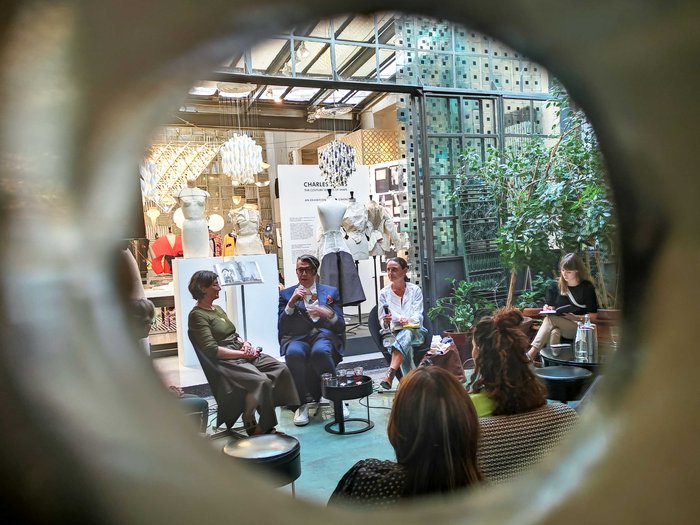 NeuigkeitMontag | 17. Juni 2019
NeuigkeitMontag | 17. Juni 2019Dorothea Mink zum Buch-Talk nach Mailand eingeladen
Nach Paris und New York wurde „Charles James – The Couture Secrets of Shape“ in Mailand präsentiert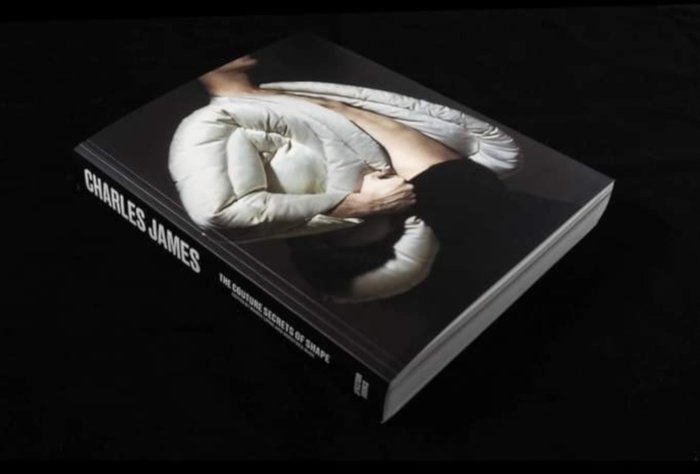 NeuigkeitMontag | 11. März 2019
NeuigkeitMontag | 11. März 2019"Charles James–The Couture Secrets Of Shape"
Publikation, März 2019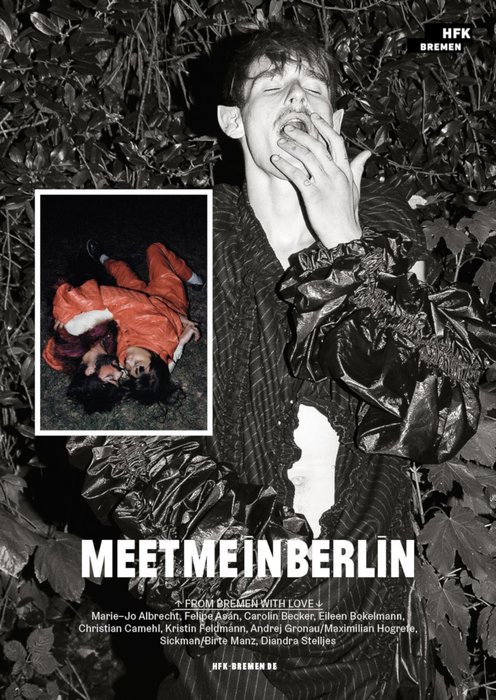 NeuigkeitDonnerstag | 17. Januar 2019
NeuigkeitDonnerstag | 17. Januar 2019HfK erfolgreich auf den "NEO.FASHION Graduate Show" in Berlin vertreten
HfK-Studierende präsentierten am 14. Januar 2019 ihre Mode-Kollektionen auf Berliner Nachwuchsshow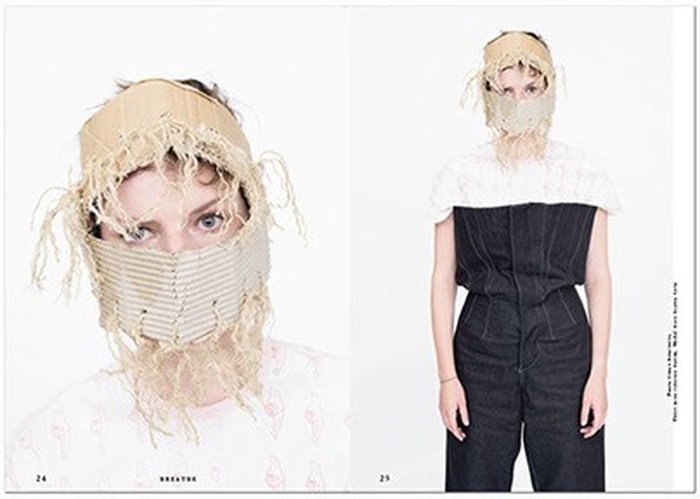 NeuigkeitDonnerstag | 5. Januar 2017
NeuigkeitDonnerstag | 5. Januar 2017Bremer Stil: „Breathe. An Idea about Fashion“
Publikation, Januar 2017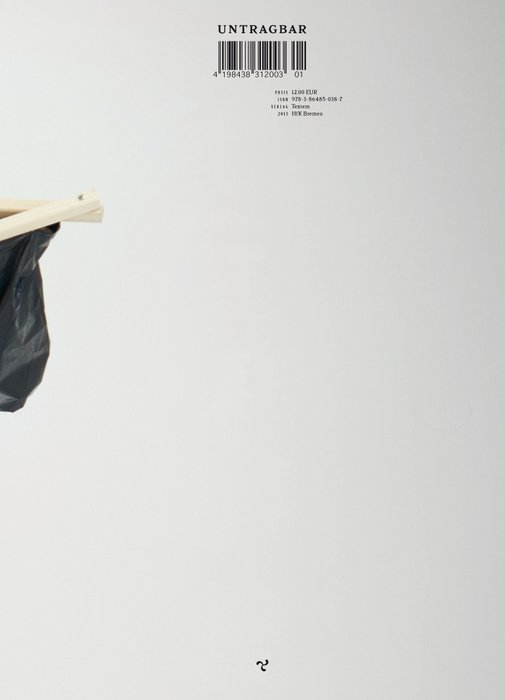 AuszeichnungDienstag | 29. April 2014
AuszeichnungDienstag | 29. April 2014Internationale Auszeichnung für „Untragbar“
Mode-Magazin der HfK erreicht Bronze im New Yorker ADC-Wettbewerb
